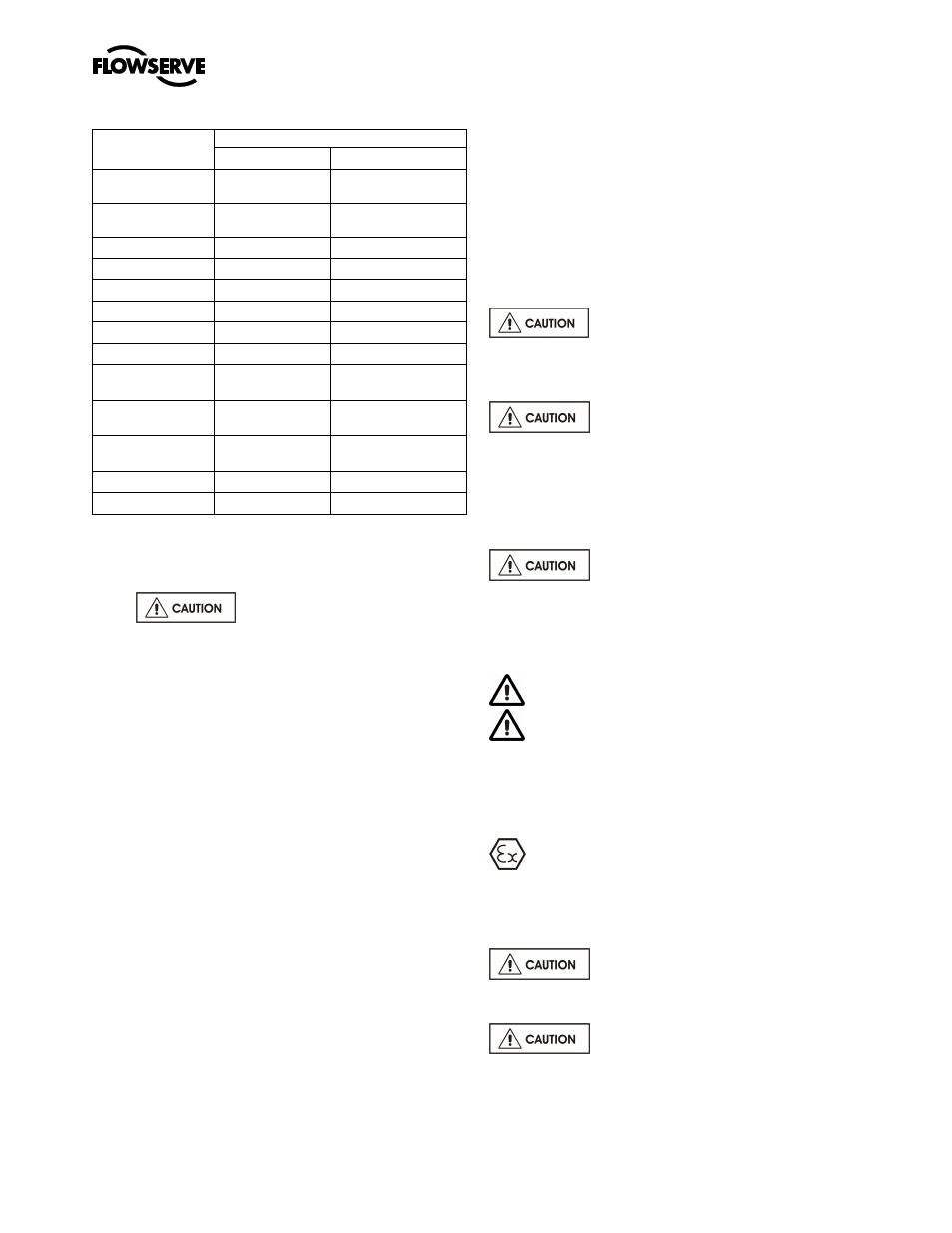3 direction of rotation, 4 guarding, 5 priming and auxiliary supplies – Flowserve LN User Manual
Page 16

LN, LNE, LNH, LNV, LNEV, LNC and LNEC USER INSTRUCTIONS ENGLISH 71576423 11-09
Page 16 of 32
flowserve.com
5.2.2 Recommended grease lubricants
Grease nipples
Grease
NLGI 2 *
NLGI 3 **
Temp. range ºC
(ºF)
-20 to +100
(-4 to +212)
-20 to +100
(-4 to +212)
Designation
according to DIN
K2K-20
K2K 30
BP
Energrease LS2
Energrease LS3
DEA
Glissando 20
Glissando 30
Elf
Elfmulti 2
Elfmulti 3
Esso
Beacon 2
Beacon 3
Mobil
Mobilux 2
Mobilux 3
Q8
Rembrandt 2
Rembrandt 3
Shell
Alvania Fett G2
Alvania Fett R2
Alvania R3
Texaco
Multilak 20
Multilak EP2
Multilak 30
Multilak EP3
Wintershall
(BASF Group)
Wiolub LFK 2
–
SKF
LGMT 2
LGMT 3
Silkolene
G55/T
G56/T
* NLGI 2 is an alternative grease and is not to be mixed with other
grades
** Factory packed bearings for the temperature range with grease
nipples
5.2.3
Lubrication schedule
5.2.4.1 Oil lubricated bearings
Normal oil change intervals are 4 000 operating hours
or at least every 6 months. For pumps on hot service
or in severely damp or corrosive atmosphere, the oil
will require changing more frequently. Lubricant and
bearing temperature analysis can be useful in
optimizing lubricant change intervals.
The lubricating oil should be a high quality oil having
oxidisation and foam inhibitors, or synthetic oil.
The bearing temperature may be allowed to rise to
50 ºC (122 ºF).above ambient, but should not exceed
82 ºC (180 ºF). A continuously rising temperature, or
an abrupt rise, indicate a fault.
5.2.4.2 Grease lubricated bearings
When grease nipples are fitted, one charge between
grease changes is advisable for most operating
conditions, ie 2 000 hours interval.
Normal intervals between grease changes are 4 000
hours or at least every 6 months.
The characteristics of the installation and severity of
service will determine the frequency of lubrication.
Lubricant and bearing temperature analysis can be
useful in optimizing lubricant change intervals.
The bearing temperature may be allowed to rise to
55 ºC (131 ºF) above ambient but should not exceed
95
°
C (204
°
F). For most operating conditions a quality
grease having a lithium soap base and NLGI
consistency of No 2 or No 3 is recommended. The
drop point should exceed 175 ºC (350 ºF).
Never mix greases containing different
bases, thickeners or additives.
5.3 Direction of rotation
Starting or operating pumps with the
wrong direction of rotation can be harmful to the
pumps. Ensure that the pump rotation is the same as
the arrow on the pump casing.
It is preferable to check the direction of rotation
before installing the coupling. If not, the pump must
be filled in with the liquid before start-up.
If maintenance work has been carried
out to the site's electricity supply, the direction of
rotation should be re-checked as above in case the
supply phasing has been altered.
5.4 Guarding
Guarding is supplied fitted to the pump set.
If this has been removed or disturbed ensure
that all the protective guards around the pump
coupling and exposed parts of the shaft are securely
fixed.
5.5 Priming and auxiliary supplies
Where there is any risk of the pump being run
against a closed valve generating high liquid and
casing external surface temperatures it is
recommended that users fit an external surface
temperature protection device.
Ensure all electrical, hydraulic,
pneumatic, sealant and lubrication systems (as
applicable) are connected and operational.
Ensure the inlet pipe and pump casing
are completely full of liquid before starting continuous
duty operation.
